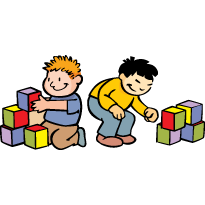Boston Children's Museum
308 Congress Street, Boston, MA 02210
617-426-6500
© Boston Children’s Museum 2025
Website Design by JackrabbitGiving clear, concise instructions to others is a critical skill for children to learn. In this game, students will be asked to identify objects using descriptive vocabulary, to differentiate between the characteristics of different objects, to listen, estimate, communicate, problem solve and observe.
Any group of objects can be used for this activity, but you will need to organize them in matching sets. For example, if one player has a yellow wooden block, a paper clip, a pencil, a plastic bottle and a blue mitten for the right hand, that student’s partner must have the same color and size block, the same color mitten, etc. You can encourage teams to collect their own objects from around the room, remembering that they will need two of everything. Start out with 2 sets of 5 objects per team and add more objects as students get better at the game. If you have them, building blocks, Tinker Toys, Lego pieces and other building toys can work well.

Ask your students if they have ever had to ask anyone for directions somewhere, or instructions on how to do something. Is it always easy to follow these instructions, or is it sometimes hard? What kinds of things can make the instructions people give hard to follow?
Can you give clear instructions to your partner so that they can match your creation?
When your students have played once, bring them together to talk about what they experienced. Was it easy or hard to create the exact same arrangement as their partner? Was it easy or hard to describe the arrangements? Does anyone have any tips for giving good, clear instructions?
Play the game again, with teammates switching roles. Have teams play a few more times, and add more objects to the mix for a greater challenge.